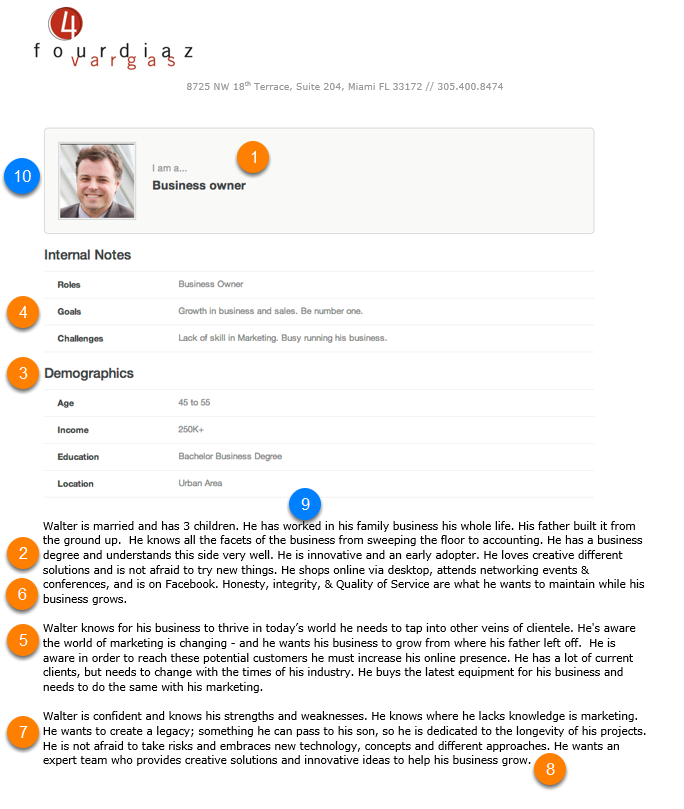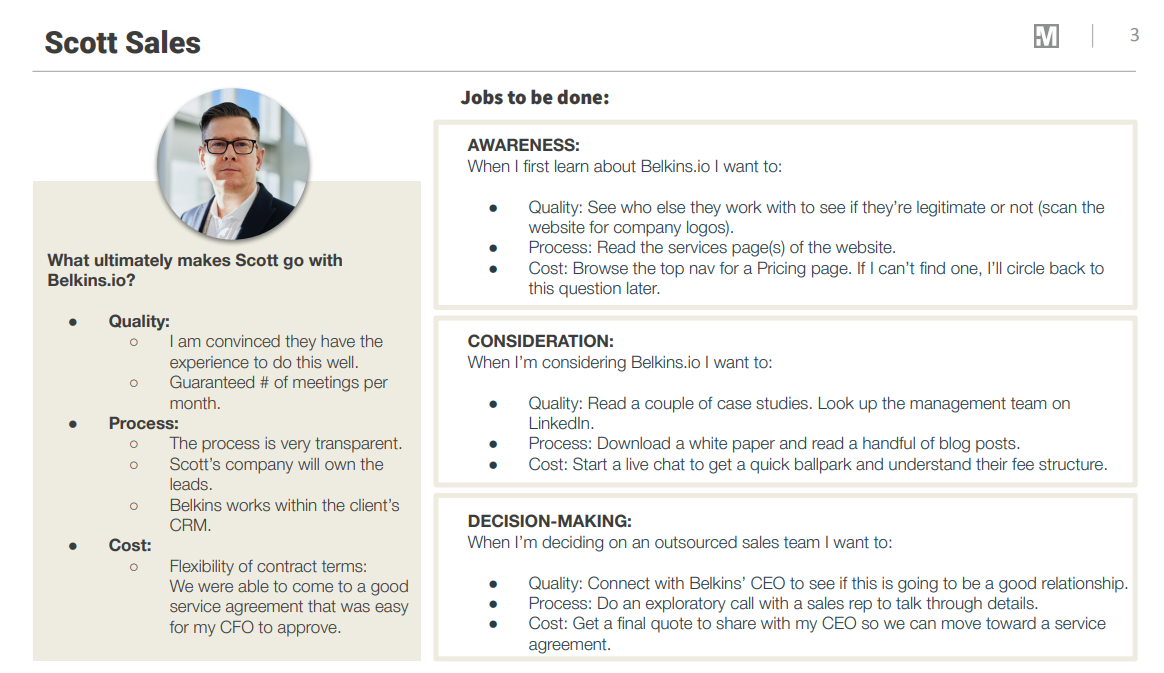In the eight years of my marketing career, I’ve always believed that good marketing ultimately boils down to how well you know your buyers.
For me, creating buyer personas has been key to truly understanding the person on the other side of the screen. These fictional profiles have helped me understand what makes my buyers tick, what keeps them up at night, and what they need to succeed.
But creating buyer personas isn’t a game of guesswork. You need a strong strategy to make accurate and nuanced personas.
In this article, I’ll share my framework with examples to help you create yours. I’ll cover:
What is a buyer persona?
Why Buyer Personas Are Essential to Your Business Growth
An Actionable Playbook on How to Create Buyer Personas
5 Buyer Persona Examples to Inspire Yours
What is a buyer persona?
A buyer persona, also called a customer persona, is a fictional profile of your ideal customer designed with on-the-ground market research. It helps you understand your buyers’ demographics, pain points, motivations, expectations, and constraints.
Over the last few years, I’ve helped several B2B SaaS companies launch strategic marketing campaigns, and if there’s one important thing I’ve learned, it’s this:
You have to really understand your buyers and speak their language to make any real impact.
Another important point to note is that there’s no one specific type of buyer. It’s important to conduct thorough audience research and build multiple buyer personas, each representing one segment of your overall target customers.
Every segment will have varying priorities, goals, challenges, and even demographics.
Jake Victor, a copywriter and growth strategist, echoes my thoughts by explaining how persona-focused marketing makes people feel “this is for me.”

When you know exactly what motivates buyers, you can use these insights to:
- Come up with relatable campaigns to stress buyers’ pain points.
- Create compelling copy and content that makes them feel heard and seen.
- Design user experiences tailored to specific aspirations and challenges.
So, I’m sharing my learnings from creating realistic buyer personas and some great examples I’ve used as inspiration.
Before I show you how to create buyer personas, let’s dive deeper into why they’re really important.
Why Buyer Personas Are Essential to Your Business Growth
Back when I was a newbie, I heard the term ‘buyer personas’ thrown around a lot. I was curious to learn why exactly good marketers were obsessed with designing buyer personas.
In the process of learning more about these personas, I realized that, traditionally, brands created marketing personas to personalize campaigns for buyers in each buyer. Today, these fictional profiles serve a bigger purpose than that.
Here are three main reasons why you need buyer personas for your business.
1. You can define the brand positioning.
When you know your buyers’ biggest pain points and challenges, you can position yourself as an ideal solution for specific problems.
Instead of shooting in the dark, you can build a more meaningful brand reputation as the go-to solution for specific challenges — like Loom for async communication. This targeted messaging also sets you apart from competitors.
2. You can enhance the user experience.
62% of businesses believe good UX positively impacts brand perception. But how exactly do you find opportunities to optimize your brand UX across all touchpoints, like your website, email, social media, etc?
With detailed buyer personas.
These personas allow you to interview the right type of customers, ask relevant questions, and collect valuable insights.
Based on all of this information, you can write relatable website copy, content, and marketing messages that resonate with your target audience, resulting in a better way to improve the user experience.
3. You’ll build cross-functional alignment.
Buyer personas are not made in a vacuum. You have to bring sales, marketing, product, and customer success teams on the same page to create accurate personas.
This early alignment between teams will pay dividends in the long run by delivering a consistent brand experience from start to finish.

Image Source
Knowing your target customers in such detail also means you can meet them where they are with meaningful solutions instead of relying on pushy sales tactics.
Ben Pines, the director of content at Wordtune, shares why he considers buyer personas so important.
“You need to go beyond demographics. That’s what buyer personas can help you with. Buyer personas help me think and feel like my buyers. Without understanding who these people are, their needs and wants, you have no way of going beyond the obvious marketing moves,” he says.
Convinced about the impact of buyer personas?
Let me share my recipe for building in-depth personas.
An Actionable Playbook on How to Create Buyer Personas
The biggest mistake I’ve seen marketers make is using stereotypes and assumptions to create buyer personas out of thin air. This generic and often inaccurate information about your customers will prove ineffective in the long run.
Here’s what I do to keep generalization at the gate and create nuanced buyer personas based on hands-on market research.
1. Collect quantitative and qualitative data about customers
The first step is the most critical link in the chain: collecting customer data. It sets the stage for the entire process.
Instead of assuming details about your target buyers, use analytics tools and conduct qualitative research to dig deeper into customer behavior.
A combination of quantitative and qualitative data will explain what buyers want and why they want something.
Let me show you how you can collect this data.
A. Use analytics tools for quantitative data.
Analytics tools will tell you how customers behave across different interactions with your brand. You can use tools like Google Analytics and Tag Manager to create custom tags and stay on top of these interactions.
Then, document everything in a CRM tool like HubSpot.
You can start by monitoring behavioral metrics like:
- The user journey. Where do customers first find you? What sequence of pages do they visit?
- Micro-conversions. What conversion milestones did they complete, like signing up for a newsletter?
- Event tracking. What actions did they take, like clicking on buttons or submitting forms?

Image Source
You can also combine this data with heatmaps (visual representation of user interactions) and session replays (recording behavior in every session) to identify the most engaging areas and see where users drop off.
This is a good way to create different customer cohorts and analyze their behavior over time before chalking out your buyer personas.
Elias Mas, a growth designer with 7+ years of experience, explains why collecting demographic data is outdated and, instead, you should focus more on understanding customer behavior.

B. Conduct user research for qualitative data.
Based on the quantitative data you’ve collected, you can create a few hypotheses to critically understand buyer motivations and behaviors.
I always found this to be the most exciting part of the research process because it reveals facts about your target customers that you could never find through guesswork.
You can create surveys, schedule user interviews, or leverage social listening to get a pulse of your buyers. The survey and interview methods will involve a set of questions specific to your hypotheses.
For example, if your hypothesis says, “Persona A is likely to use our product for the Z use case,” then your interview/survey questions will dissect Persona A’s problems related to that use case.
You can ask them about challenges, expectations, jobs to be done, and current workflows related to that use case.
Here are a few examples of interview questions:

Image Source
Alternatively, you can monitor brand mentions for your competitors or analyze content for specific keywords to collect inputs from social media.
2. Study the data and gather insights from every team.
Once you’ve collected a wealth of data to create a foundation for your buyer personas, the next step is to draw meaningful insights from this raw data and come up with an initial assessment of buyers’ characteristics.
This step is essentially about organizing the data into different parameters for defining your buyer personas. This analysis will reveal trends and patterns to take you from a broad understanding of your customers to a more nuanced view.
Here are some key parameters to categorize your research:
- Role or work profile. What position do they work in?
- Company type. What’s the company size and growth stage they represent?
- Jobs-to-be-done. What do they want to achieve using your solution?
- Major pain points. What’s keeping them up at night that you can solve?
- Primary motivations. Why should they buy from you over other brands?
- Buying intent and budget. What’s their budget and level of urgency to solve the problem?
Each parameter will come together to convey a complete story about your persona.
Mike, an eCommerce entrepreneur, shares an example of how detailed personas build a deeper understanding of who you’re selling to.

You can analyze audience research collectively with different stakeholders to collect multiple perspectives. For example, how your marketing team looks at the data will differ significantly from your product or design team’s perspective.
These varying perspectives will give you a 360-degree view of your user experience.
3. Define your use cases and solutions for each segment.
Now that you’ve categorized buyers into different groups mapped to their main characteristics, it’s time to explain how your product/service fits into the picture.
You have to identify your core value propositions for each segment tailored to their use cases and pain points. Dig deeper into how you can tackle buyers’ challenges and highlight the particular benefits of your product/service.
Then, you can create a persona-specific matrix to document the challenges, expectations, solutions, and benefits. Here’s one I created on Miro to make such a matrix for my clients.
I’ve also filled out this matrix for a hypothetical brand that sells sustainable, eco-friendly products.

4. Document your personas using a tool or template.
Once you’ve done all the legwork to collect and organize your audience research data, you can start documenting your personas.
In the past, I’ve used tools like Notion or a simple Google Docs file to record all the insights about my personas and make them as detailed as I want.
But now, I’ve switched to HubSpot’s Make My Persona tool, as it lets me make these personas visually appealing.
A bit about this tool: it collects different insights about your buyers to create a neat persona document like the one below. You can easily customize this information and add more sections to include in-depth information.
It’s an easy solution to visualize all the details and share your personas via a link or a file.

Image Source
5. Create a workflow to update personas regularly.
Your buyers’ expectations are constantly evolving. So, the final step in my process is making a workflow to consistently review these buyer personas and update them based on market shifts.
I speak with customers from every segment to understand how their priorities have changed and what they expect from our brand.
These conversations, paired with customer data from analytics tools, can reveal new trends and shifts in customer behavior that you didn’t know before.
This new information can help you fine-tune buyer personas to reflect current customer needs.
Save this guide to create (or refresh) your buyer personas and get a pulse of your target audience. It’s easy to document your personas with HubSpot’s free buyer persona maker. Get started here.
5 Buyer Persona Examples to Inspire Yours
Ready to create your buyer personas? I’ve curated five amazing buyer persona examples to give you some inspiration. Let’s break down what we like in each example.
1. Visual Creatives

Image Source
Visual Creatives’s primary buyer personas is typically an agency owner or founder. They analyzed their most profitable and long-term customers to create this fictional profile of an ideal customer.
What I Like
By thinking about what a day in the life of your buyer looks like, you can better understand their challenges and the jobs to be done.
Visual Creatives did this really well and documented the fact that their persona is struggling for time throughout their day and typically finds the information they need on the web.
This insight shows that a company can communicate with an agency owner by creating easy-to-find, relevant, and educational content online rather than by contacting them on the phone or through email.
2. HUCACE

Image Source
HUCACE created a fictional persona of an HR Manager. The persona explains Tina’s goals in detail and sets the right context by highlighting some of the biggest challenges in her daily responsibilities.
What I Like
This persona shares a story about Tina’s personal and work life to communicate her motivations and struggles.
It shows how the persona researches information online and chats with her colleagues to discover best practices.
This means that she could be influenced by social proof, so HUCACE should think about how they could use things like testimonials, social media, and referral programs to drive conversions.
The story also focuses on qualities she’s looking for in a vendor so HUCACE can emphasize those values in its messaging.
3. Fourdiaz Vargas

Image Source
Fourdiaz Vargas created a buyer persona for a business owner named Walter. Besides demographic details, this persona describes some aspects of Walter’s personal life, his preferences, and his personality.
What I Like
This persona pays close attention to Walter’s specific goals and preferences. It goes above and beyond to give readers complete context around the persona, like his behavior, needs, habits, and more.
This style requires in-depth research to cover every aspect of buyer profiles, from objections to motivations.
4. Belkins


Image Source
One of Belkins‘s buyer personas is a sales leader at a high-growth tech company. This document contains multiple objections and questions that this buyer will likely ask.
It also creates a story around the circumstances when the buyer would look for Belkins’s services.
What I Like
The company analyzed its past case studies to realize that three things matter the most to its customers: quality, process, and cost. So, this buyer persona example lists different jobs to be done across these three aspects.
This JTBD framework works well for Belkins’s team to interact with potential customers in different stages of the sales funnel.
5. Webflow

Image Source
This is a fictional buyer persona created for Webflow. It’s a quick template to record crucial details about buyers, like their core use cases, goals, pains, interests, and more.
What I Like
This buyer persona example is super easy to fill out with only the most relevant details. Instead of covering demographics, it directly covers useful information like the buyer‘s role + background, and what they’re looking to do with Webflow.
It also summarizes their interests/expectations and lists the main reasons why they’d go for a platform like Webflow over other options.
6. Trello

Image Source
This buyer persona talks about a user’s interests, goals, and challenges, specifically from the lens of Trello’s main features and use cases. It also conveys the user’s story to better contextualize their daily struggles in their role.
What I Like
The section on “Why Trello” brings every detail together to explain how Trello is the ideal solution for this user.
The section draws on other information about their challenges and goals to list four concrete reasons why Trello is exactly what this user needs.
With this persona, Trello’s team is now aware of what matters the most to this user segment and how they can sell to them.
7. Harlow

Image Source
Harlow’s buyer persona focuses on each user’s personal characteristics and priorities. This is great for creating marketing campaigns that resonate more with each user segment.
What I Like
This buyer persona shares all essential details about the target user with a human picture to add a realistic touch to it. It briefly covers users’ interests and hobbies to ensure Harlow’s brand image aligns with these values.
8. Loom

Image Source
This buyer persona accurately documents one of the biggest target users for Loom: a sales representative. This sales rep works in a global market, and their profile describes what they expect from a tool like Loom to win at their job.
What I Like
This buyer persona is neatly packed in four boxes, each detailing a specific aspect of the user. Without going into too much detail, it lists key characteristics — like the user’s main interests, frustrations, and expectations.
This information can be useful for building Loom’s messaging, specifically for sales teams. It also highlights the pain points that Loom can stress when positioning its solution.
Make Buyer Personas Work for You
Buyer personas are more than just a generic snapshot of your target customers. Done right, these personas can guide your overall growth strategy and impact every aspect of the customer experience.
You can use buyer personas to inform sales decisions, create brand messaging, approach marketing campaigns, and a lot more.
10 Creative Company Profile Examples to Inspire You
Best AI Chatbots: Our Top 18 Picks for 2023
19 Best Email Newsletter Templates and 12 Resources to Use


